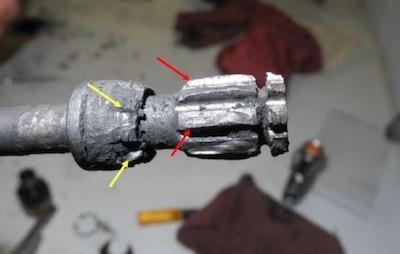Cites Failed Engine Pump Aboard The Bell 206L Aircraft
The NTSB has released a probable cause report from an accident which occurred April 4, 2016 involving a Bell 206L helicopter near Pigeon Forge, TN. The accident fatally injured the five people aboard the aircraft.

The helicopter was registered to a private individual and operated by Great Smoky Mountain Helicopters, Inc., doing business as Smoky Mountain Helicopters.
According to the report, the commercial pilot and four passengers departed in the helicopter on a local air tour flight. A witness observed the helicopter at a low altitude in a descent and noted that it sounded unusual. He then heard the engine go silent, which was followed by sounds associated with impact.
Examination of the accident site revealed that the helicopter initially impacted trees near the top of a ridge at an elevation of about 1,100 ft mean sea level and came to rest in a wooded area near the bottom of the ridge. The main wreckage was mostly consumed by a postcrash fire. The main and tail rotor blades exhibited signatures of low rotational energy consistent with unpowered ground impact damage. Disassembly of the engine fuel pump revealed anomalous and accelerated spline wear that was severe enough to prevent the fuel pump from delivering fuel to the engine, resulting in a total loss of engine power.
The wear on the splines was likely accelerated due to a lack of grease. Remnant material on the fuel pump splines was consistent with grease being present at some time on the drive gear and drive shaft splined connection, but it could not be determined if it was from the last overhaul which was performed about 8 years and 1,078 flight hours before the accident or from an earlier overhaul. Drive gear spline impressions on the drive shaft spacer were consistent with an erroneously selected spacer. The incorrectly-sized spacer could have resulted in a gap between the spacer and drive gear that provided a path for grease that was applied on the splines to escape. According to records from the most recent fuel pump overhaul and the overhaul facility, the spacer was not replaced during the last overhaul. Because overhaul records preceding the most recent fuel pump overhaul were not available, it could not be determined when the incorrectly-sized spacer was introduced into the fuel pump assembly.

Following an inflight loss of engine power, an autorotative landing can be accomplished if the pilot successfully enters the autorotation, the helicopter has adequate altitude and airspeed, and rotor rpm is managed throughout the autorotative descent. The lack of crash-resistant data and cockpit image recorders, radar data, or surveillance videos precluded determination as to why the pilot was not able to successfully complete an autorotation.
Based on the described injuries in the autopsy reports, the accident was likely survivable for the pilot and one passenger had they received immediate emergency treatment and not been subject to a postcrash fire. One of the passengers would not have survived based on their injuries. The investigation was unable to determine whether two of the passengers would have been able to survive their injuries had they not been subject to a postcrash fire.
The helicopter was not equipped, nor was it required to be equipped, with a crash resistant fuel system. Crash resistant fuel systems are intended to reduce the risk of fuel spillage and provide additional egress time for occupants. At the time of the accident, a modification to the accident make and model helicopter was available from the manufacturer (at a cost) to incorporate a fuel system with improved crash resistance. This modification was not certified to the current airworthiness standards but was tested to similar standards and would have improved the crash resistance of the helicopter's fuel system. Due to the lack of recorded data, such as a flight data recorder or videos capturing the crash, the conditions at the time of impact, such as helicopter attitude and airspeed, are unknown. Therefore, the effectiveness of a crash resistant fuel system, either one that met the current airworthiness standards or the available manufacturer modification, in preventing a postcrash fire could not be
determined in this investigation.
The NTSB determined that the probable cause(s) of this accident were an inflight loss of engine power due to a failure of the engine fuel pump, which resulted in a collision with trees and terrain during the subsequent autorotation. The failure of the engine fuel pump resulted from the absence of adequate grease leading to accelerated spline wear within the fuel pump.
(Source: NTSB. Images from NTSB Accident Docket)
 ANN's Daily Aero-Term (04.28.24): Airport Marking Aids
ANN's Daily Aero-Term (04.28.24): Airport Marking Aids Aero-News: Quote of the Day (04.28.24)
Aero-News: Quote of the Day (04.28.24) ANN's Daily Aero-Linx (04.28.24)
ANN's Daily Aero-Linx (04.28.24) Aero-News: Quote of the Day (04.29.24)
Aero-News: Quote of the Day (04.29.24) ANN's Daily Aero-Linx (04.29.24)
ANN's Daily Aero-Linx (04.29.24)




